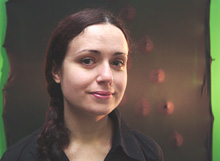MFA exchange program brings fresh perspective

Bianca Mancini
Photo by Kate Hutchinson
Bianca Mancini enjoys art experienced outside of its traditional context, and generated by unusual sources. This poses interesting challenges for her as an artist. It means including non-artists as collaborators and presenting the results in surprising venues.
“I like art that rejects its romantic ideal,” Mancini explained. Art should not only question values through its content, but also through its format.
Mancini’s theories on public, or participatory, art are her driving passion. The 25-year-old Brazilian, who last semester studied in Concordia’s Master of Fine Arts Program as an exchange student from Germany, has an artistic pedigree as varied as her passport.
Mancini’s diverse background and fresh perspective are what the exchange program is all about, said Andrew Dutkewych, director of the MFA Studio Arts program.
“Having exchange students is interesting and important,” he said. Participating schools are greatly enriched by the presence of students who add to the established local artistic dialogue, techniques and media used.
In the decade that Concordia has participated in such graduate art student exchange programs, the university has sent and/or hosted two or three students per year, usually second-year students. Participating institutions include the Glasgow School of Art, and Sweden’s Gothenburg University as well as Germany’s Bauhaus University.
Born and raised on Florianopolis, an island off Brazil’s southern coast, Mancini thought of handicrafts as “women’s art” until she came to Montreal. “I love the handicraft influence on contemporary art here,” she said.
Her previous work had included photography and performance art. Now she feels her methods of expression have been liberated and she intends to try a whole new range of artistic media.
“People [here] feel free to apply traditional media to contemporary settings.” Professor Dutkewych’s sculpture and Therese Chabot’s work with flowers have had a particular influenced on her.
Mancini has been creating a tallit, the traditional Jewish man’s prayer shawl. Mancini’s twist is that her tallit is inspired by interviews she conducted with women about their Jewish identity.
“I’m fascinated by the fact that tradition says we can’t use icons to describe Jewish identity, only feelings,” she said.
Another recent project came out of encounters with new immigrants to Montreal. “I like to play with people’s stories,” explained Mancini.
She installed five “memorial” plaques on public benches, each dedicated to one of the city’s largest immigrant communities: Morocco, China, Pakistan, India and Haiti. “The city offers you a lap,” reads the inscription.